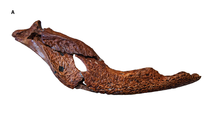| Mekosuchus | |
|---|---|

| |
| Mekosuchus inexpectatus mandible | |
| Scientific classification | |
| Domain: | Eukaryota |
| Kingdom: | Animalia |
| Phylum: | Chordata |
| Class: | Reptilia |
| Clade: | Archosauromorpha |
| Clade: | Archosauriformes |
| Order: | Crocodilia |
| Clade: | †Mekosuchinae |
| Genus: | †Mekosuchus Balouet & Buffetaut, 1987 |
| Type species | |
| †Mekosuchus inexpectatus Balouet & Buffetaut, 1987
| |
| Species | |
| |
Mekosuchus is a genus of extinct Australasian mekosuchine crocodilian. Species of Mekosuchus were generally small-sized (less than 2 m (6 ft 7 in) long), terrestrial animals with short, blunt-snouted heads and strong limbs. Four species are currently recognized, M. inexpectatus, M. whitehunterensis, M. sanderi and M. kalpokasi, all known primarily from fragmentary remains.
Mekosuchus was a successful and widespread genus, with its earliest members being found during the Oligocene and Miocene in mainland Australia. These species coexisted with a wide variety of other mekosuchines, forming a highly diverse crocodilian fauna including terrestrial hunters, semi-aquatic ambush predators and long-snouted fish eaters. The anatomy of the neck vertebrae of M. whitehunterensis might indicate that it was quite well adapted to stripping flesh from carcasses, using blade-like teeth and violent side-to-side thrashing.
The younger two species were found on the Pacific islands of New Caledonia and Vanuatu respectively and represent some of the youngest known mekosuchines. Mekosuchus possibly died out approximately 3,000 years ago, during the Holocene, but some authors have also suggested that they may have survived until even more recently. Unlike the mainland species, M. inexpectatus is known to have had bulbous posterior teeth that may have been used to crack the shells of crustaceans and molluscs. Some researchers suggest that they were possibly nocturnal animals living in close association with rainforest streams. What caused their extinction is unclear. Although some researchers suggest a human cause, others point out that the potential overlap with human settlements is insufficiently understood and no direct signs of human involvement have been found.